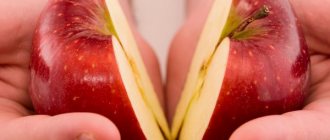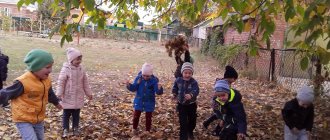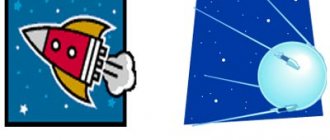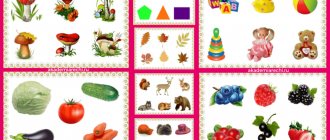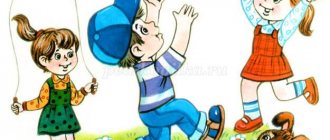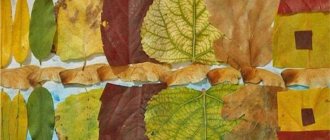Didactic games “Trees” in the younger group
We offer simple and exciting games that help younger preschoolers get acquainted with the world of flora.
One, two, three - hug the tree!
It is better to play outdoor games in a park where there are many different plants. The presenter names a tree of a certain type, says: “One, two, three - hug the tree!” Children look for the plant named by the leader, and when they find it, they run up to it and clasp it with their hands.
Find the odd one out
The game is designed to develop visual perception and observation skills. First hang natural objects that are not related to them on the plants growing in the yard. For example, on a birch - an acorn, on a fir tree - a maple leaf, on an oak - a pine cone. The task of preschoolers going out for a walk is to carefully examine the plants and find the odd one out.
Crafts
The activity develops imagination and creativity. For the game, collect natural materials: cones, fallen leaves, seeds, birch catkins, pieces of bark, acorns, maple “spouts”. Invite students to make crafts from the collected material. Each child creates some kind of appliqué, painting, three-dimensional composition. Then he tells what parts of the tree he used to create the artwork. At the end of the lesson, you can make an exhibition of children's works with discussion.
Wood parts
The activity develops memory and thinking abilities. Younger preschoolers will learn the names of plant parts.
Print out a realistic image of a tree, tell the children what a trunk, branches, roots are, explain that the collection of leaves is the crown. During the explanation, children should look at the picture.
Didactic game: “Autumn Adventure”, for children 4 - 7 years old
Author:Lyanguzova Olga Zhanovna
Position:
teacher - speech therapist
Place of work:
MKDOU No. 18, Miass, Chelyabinsk region
Purpose of the material:
the game can be used by specialists in working with preschool children aged 4 - 7 years, including for children with disabilities.
Equipment:
1 playing field, 9 pictures of leaves, 9 pictures of trees.
Goal:
development of observation, visual attention and memory
Objectives:
1. Activate children’s knowledge on the topic: “Autumn. Trees in autumn"
2. Develop the ability to form relative adjectives, develop basic mental processes.
3. Develop the ability to obey the rules of the game and play in a group of peers.
Form of organization:
individual or subgroup (2-3 people)
Preliminary work:
familiarization with the image of leaves and trees.
Progress of the game:
1 option
In front of the children there is a playing field of 9 sectors. Each sector contains 3 pictures depicting autumn leaves (chestnut leaf, oak leaf, willow leaf, aspen leaf, linden leaf, poplar leaf, rowan leaf, maple leaf, birch leaf).
The first move is determined by the counting rhyme:
"One two three four five.
We will collect leaves.
If you find a leaf,
I went first and played.”
If 3 children are playing, then each is given 3 pictures depicting single leaves.
The first player examines his leaves and the first sector on the playing field, if he finds among his leaves a similar one on the field, then he closes the sector with it and correctly names the leaf (chestnut leaf). Then considers the next sector. If the required sheet is not available, then the turn passes to the next player.
If there are 2 children playing, then we distribute 3 pictures to each and put 3 next to each other in a pile (with their shirts up) - “on the path.” The game is similar, but if the required sheet is not available, then it must be taken from the path. Only after this the turn passes to the other player.
The players' task is to get rid of their cards as quickly as possible.
The adult monitors the correct completion of the task and the formation of relative adjectives, correcting if necessary. If the child does not form the word correctly, he must stop and repeat the adjective correctly 3 to 5 times (maple, maple, maple)
Option 2
The game is played similarly to the previous one, with the only difference, instead of leaves, children are offered with images of trees. Thus, the task becomes more difficult, since children need to determine which tree the leaf comes from. In this version of the game, the child points to a leaf and introduces a relative adjective into the sentence: “A willow leaf from a willow tree.”
Making the game:
Word.
The picture material is taken from the Internet (links from sources are located below).
In the search engine we type the word CLIPART (picture on a transparent background) and the name of the picture. Select the required image, copy and paste it into the document. To remove the background, perform the following steps: WORK WITH THE DRAWING - REPAINT - SET A TRANSPARENT BACKGROUND.
So that the picture can easily move on the sheet, you need to click on the right mouse button, select OBJECT FORMAT - TEXT WRAP - BEFORE TEXT. The entire material can be downloaded from the “Download” link.
Didactic games "Trees" in the middle group
Games intended for the middle age group continue to introduce preschoolers to the signs and characteristics of different trees, foster curiosity, broaden their horizons, develop speech skills and the ability to think logically.
What grows on what?
The presenter begins the phrase, and the players logically continue:
- there are... apples hanging on the apple tree;
- there are... earrings hanging on the birch tree;
- there are... nuts hanging on the hazel tree;
- there are... acorns hanging on the oak tree;
- there are... pine cones hanging on the tree.
Make up a picture
For the game, prepare pictures depicting trees familiar to preschoolers, cut them into several arbitrary parts. Hand out the cut images to the children and ask them to put the parts of the picture together into a single whole. Having completed the task, the child carefully examines the picture, says what plant he sees, and describes it. For example: “This is oak. He's big and strong. This is a forest tree. There are acorns hanging on it.”
Guess by description
The presenter names a list of signs, and the children try to guess what plant they are talking about:
- slender, with a white trunk, with earrings, curly, thin - birch;
- prickly, triangular, covered with needles, with wide legs, green in winter - a Christmas tree;
- strong, with a thick trunk, with acorns on the branches, with a wide crown, centuries-old - oak;
- weeping, slender, with long branches, bending over the water - willow;
- beautiful in autumn, with large carved leaves - maple.
Say an adjective
The presenter says the name of the tree, and the players take turns calling the defining adjective:
- birch, and the sap... birch;
- pine, and the cone... pine;
- aspen, and the leaf... is aspen;
- oak, and the furniture... oak;
- poplar, and the fluff... poplar;
- bird cherry, and the color... bird cherry;
- apple tree, and jam... apple;
- linden, and honey... linden;
- spruce, and the paw... is spruce.
Good or bad
Have the players split into two groups. The first in line should name everything that benefits the trees. For example, watering, sun, rain, fertilizer, bees, heat. The latter call what is harmful to plants. For example, insects, fire, cold, frost, heat, drought. It is important that children explain their opinions in detail.
Didactic games “Trees” in the senior group
In the older group, preschoolers learn to distinguish, describe, classify, their ideas about the world around them expand, and speech skills develop.
Tell me about the leaf
The game teaches how to compose complex sentences; preschoolers' understanding of colors and shapes expands. For the activity, prepare dried leaves of different types of trees familiar to the children. Or print realistic images. Each student takes turns choosing the piece of paper that he likes more than the others and tries to describe it in detail.
Find a tree
It is better to play the game in a park where there are many different types of flora familiar to preschoolers. Children look at the plants around them, while listening carefully to the teacher. And he talks about the tree without naming it. Based on the description they hear, children must guess what plant they are talking about. For example, here is a description of the rowan: “A slender tree with long and narrow leaves, collected together in several pieces. In autumn, berry clusters form on the branches. The berries are small and red; bullfinches love to feast on them.”
I am a tree
Outdoor play promotes physical development, stimulates imagination, and broadens one's horizons. Before class, discuss with your students that trees come in different shapes and sizes: with a narrow and wide crown, with branches pointing up or down. Let the students imagine that they are trees: their arms are branches, their legs are roots, their torso is a trunk. Each child imagines himself to be a plant of a certain type, but does not say what kind.
Each player takes turns standing in front of his comrades, using gestures and body movements to depict the tree and what is happening to it. The other players guess what their friend is trying to show. For example, when imitating an oak tree, a child demonstrates that he is strong, spreads his legs, sticks out his chest, and makes sounds that imitate the rustling of leaves in the wind, the chirping of birds on the branches. When depicting a willow, the player makes a sad face, imitates crying, and limply lowers his hands.
What's extra?
The game teaches you to classify plants according to key characteristics. For the lesson, make cards, each of which should depict 4 types of trees, one of which belongs to another category.
Players look at the images one by one, identify the odd plant, and select a unifying category for the rest. If the player makes a mistake, the right to move is transferred to the next child. The one who correctly identified the extra tree gets a point. The winner is the one who scores the most points.
Here are examples for the game:
- maple, aspen, spruce, poplar - category of deciduous species;
- spruce, cedar, pine, chestnut - coniferous species;
- aspen, pear, cherry plum, apple tree - fruit crops;
- lilac, birch, jasmine, bird cherry - shrubs.
Fly to me, leaf
For active play, you need dried fallen leaves of different types and silhouette views of the same leaves. Players receive silhouettes one at a time. The teacher stands at the other end of the room and shows the dried leaves to the children. For example, he shows a maple leaf and calls: “Fly to me, maple leaf.” The player, who sees the corresponding outline, runs up to the teacher and talks about the features characteristic of the tree to which the demonstrated leaf belongs.
The game can be complicated by not naming the type of plant, but simply saying: “Fly a leaf to me.” Then the child, who has discovered the corresponding contour, must himself determine the species of the tree, then talk about it.
DIY didactic game on the topic: Autumn for older children
A guide for playing autumn fun in kindergarten for children of senior preschool age
Author: Svetlana Nikolaevna Kryuchkova, music director of MDOU Kindergarten No. 127 “Northern Fairy Tale”, Petrozavodsk Description of the material: the material may be of interest to music directors and educators when organizing leisure activities Goal: creating a game situation for autumn entertainment Objectives: - development of creative abilities for preschoolers - to expand children's understanding of the plant world - to consolidate the basic characteristics of trees.
Children with great desire participate in games and play situations that are offered to them for entertainment. I would like to present to your attention the author’s manual “DRESS UP THE TREES”, which I use during autumn entertainment. For the manual, I drew 3 tree trunks on whatman paper - birch, oak, rowan. I cut out leaves for these types of trees. For durability, it is better to laminate the leaves; they will last longer and will always look fresh. I glued magnetic strips on the back of the leaves (I used soft magnetic pictures), because the game is played using magnetic boards.
As an option, you can make a game for the flannelgraph by gluing flannel onto the leaves on the back side and using the flannelgraph.
Attach tree trunks with magnets to easels with a magnetic surface. Before the game starts, the host asks riddles and the children guess which tree they are talking about.
What kind of tree is this that decorates the forest in winter?
Red clusters on the branches - Well, guess, kids: Not an alder and not an aspen, But a beauty... (ROWAN)
Strong, slender and strong, After all, he is the lord of the forest.
He is a living witness for us in the oblivion of centuries gone by. It's a good-quality log house. Did you guess it? This... (OAK)
In a white sundress They stood in a clearing, The tits flew, They sat down on their braids.
(BIRCH) At autumn entertainment, the game can be played by any character or presenter.
The wind was blowing through the forest and ripping off all the leaves from the trees.
We will collect leaves and select them for trees. The trees will be very happy when we give them clothes. The game involves 3 people. Everyone selects leaves for the tree offered to him. Alternatively, the game can be played in teams - dividing the total number of children into 3 teams. To complicate the task, you can add maple and viburnum leaves to the basket with leaves. Children, on command, approach the basket, select a leaf suitable for the tree and attach it to the easel.
As a musical accompaniment I include the song “Colorful Autumn” by Tatyana Morozova.
We had a lot of fun, We played and frolicked, All the trees are very happy, After all, they are now wearing outfits.
We recommend watching:
Autumn entertainment for children of middle and senior preschool age Games with mushrooms for an autumn matinee Quiz on the theme “Autumn” in the preparatory group A theatrical game in the middle group on the theme “Autumn”. Abstract
Similar articles:
Autumn games for children of the preparatory group in kindergarten
Father's Day for older children. Scenario
Autumn theatrical performance at the preschool educational institution. Senior group
Autumn walk “Watching the sky” in the senior group
Autumn walk “Watching the rain.” Senior group
Didactic games “Trees” in the preparatory group
The presented games expand the understanding of plant species, develop imagination and thinking abilities, and form basic mathematical and lexical knowledge.
Trees
The purpose of the didactic game “Trees” is to get acquainted with the diversity of flora and teach the skill of identifying and distinguishing plants. The game is played in the form of a lotto, it requires 24 cards depicting different types of flora, and 4 playing fields, divided into 6 cells with images of the corresponding plants.
The presenter distributes the playing fields to the players. Then he shows the cards one by one and names the plant depicted. The child who finds the corresponding image on his field receives a card. The game ends when one of the players covers all the cells of the field with pictures, he becomes the winner. But before this, the player must name the category that includes the plants on his field. For example:
- aspen, poplar, maple, chestnut, linden, rowan - deciduous species;
- jasmine, lilac, sea buckthorn, hawthorn, bird cherry, mimosa - shrubs;
- spruce, cedar, juniper, pine, thuja, cypress - conifers;
- Apple, apricot, plum, cherry plum, pear, cherry are fruit crops.
Didactic game “Which tree is the leaf from?”
For the game, prepare cards on which trees of 4 different types are depicted at the top, and 4 leaves below them. For example, at the top are images of maple, aspen, birch, and rowan, and below them are aspen, rowan, maple, and birch leaves. Ask the student to correctly connect the plants with leaves: draw lines between them.
What is a tree?
The presenter begins a phrase on the importance of plants for living beings and people, and the players take turns continuing:
- a tree for birds is... a home, a resting place, a place to build a nest, a feeder;
- for painters - an artistic object, the basis of a landscape, an object of inspiration;
- for beetles - housing, food, place of laying eggs, place of hibernation;
- for travelers - a place of rest, protection from the scorching sun;
- for builders - material for building houses;
- for carpenters - material for making furniture.
Trees
The game is recommended not only for preschoolers in the preparatory group, but also for younger schoolchildren with speech impediments. For the lesson you need sets of cards of 4 categories: numbers from 1 to 10, two options for signs and the trees themselves. From the cards presented, the child makes sentences that he pronounces out loud. First, you should show your preschooler how to do this. The first card in a row is laid out with a number, then a picture of a plant, and at the end there are 2 cards with characteristics.
For example, a child posts the number 3 and a picture of an aspen tree. Pronounces: “Three aspens.” Between these cards he places symbolic images of the characteristics of the object: tall and slender. Says the full sentence: “Three tall slender aspen trees.”
